Spatiotemporal Dynamics of Ecosystem Water Yield Services and Responses to Future Land Use Scenarios in Henan Province, China
Abstract
1. Introduction
2. Materials and Methods
2.1. Study Area
2.2. Data Sources
2.3. Methods
2.3.1. Technical Roadmap
2.3.2. InVEST Model WY Module
2.3.3. The PLUS Model
- (1)
- BAU: Under this scenario, this study observed that the development and change pattern observed in the 2010–2020 period would be maintained in the future; the changes in various LULC in Henan would be affected by natural conditions and economic factors, rather than by policies or other external factors.
- (2)
- CPS: Under this scenario, strict measures would be implemented to protect cultivated land. The probability matrix of land transfer would be revised based on the BAU scenario, revealing a 60% reduction in the probability of cultivated land being converted to construction land.
- (3)
- ES: Under this scenario, measures would be taken to reduce the probability (by 50%) of woodland areas, grassland areas, and water being converted to construction land. Additionally, the probability of cultivated land being converted to construction land would decrease by 30%. The saved area would be allocated for the conversion of cultivated land to woodland, promoting ecological conservation.
- (4)
- HDS: Under this scenario, the probability of woodland, grassland, and cultivated land areas being converted to construction land area would increase by 20%. Conversely, the probability of construction land area being converted to woodland, grassland, and unused land areas would reduce by 30%. Moreover, the conversion to cultivated land would decrease by 10%, aimed at high-quality and sustainable development outcomes.
2.3.4. Model Validation
2.3.5. Spatial Autocorrelation
3. Results
3.1. Characteristics of Spatial and Temporal Changes in WY in Henan Province
3.2. WY of Different Land Use Types
3.3. Future LULC Projections
3.4. WY Response Simulation
4. Discussion
4.1. Analysis of Spatial and Temporal Trends of WY
4.2. Impact of LULC Change on WY
4.3. Recommendations for Future Water Resources Management
4.4. Research Limitations and Prospects
5. Conclusions
Author Contributions
Funding
Data Availability Statement
Acknowledgments
Conflicts of Interest
References
- Filho, W.L.; Totin, E.; Franke, J.A.; Andrew, S.M.; Abubakar, I.R.; Azadi, H.; Nunn, P.D.; Ouweneel, B.; Williams, P.A.; Simpson, N.P. Understanding responses to climate-related water scarcity in Africa. Sci. Total. Environ. 2022, 806, 150420. [Google Scholar] [CrossRef] [PubMed]
- Shen, Y.; Chen, Y. Global perspective on hydrology, water balance, and water resources management in arid basins. Hydrol. Process. 2010, 24, 129–135. [Google Scholar] [CrossRef]
- Mekonnen, M.M.; Hoekstra, A.Y. Four billion people facing severe water scarcity. Sci. Adv. 2016, 2, e1500323. [Google Scholar] [CrossRef]
- Sánchez-Canales, M.; Benito, A.L.; Passuello, A.; Terrado, M.; Ziv, G.; Acuña, V.; Schuhmacher, M.; Elorza, F.J. Sensitivity analysis of ecosystem service valuation in a Mediterranean watershed. Sci. Total. Environ. 2012, 440, 140–153. [Google Scholar] [CrossRef] [PubMed]
- Lang, Y.; Song, W.; Zhang, Y. Responses of the water-yield ecosystem service to climate and land use change in Sancha River Basin, China. Phys. Chem. Earth Parts A/B/C 2017, 101, 102–111. [Google Scholar] [CrossRef]
- Zheng, H.; Li, Y.; Robinson, B.E.; Liu, G.; Ma, D.; Wang, F.; Lu, F.; Ouyang, Z.; Daily, G.C. Using ecosystem service trade-offs to inform water conservation policies and management practices. Front. Ecol. Environ. 2016, 14, 527–532. [Google Scholar] [CrossRef]
- Wu, L.; Liu, X.; Yang, Z.; Yu, Y.; Ma, X. Is Climate Dominating the Spatiotemporal Patterns of Water Yield? Water Resour. Manag. 2023, 37, 321–339. [Google Scholar] [CrossRef]
- Watson, F.G.; Vertessy, R.A.; Grayson, R.B. Large-scale modelling of forest hydrological processes and their long-term effect on water yield. Hydrol. Process. 1999, 13, 689–700. [Google Scholar] [CrossRef]
- Su, C.; Liu, H.; Wang, S. A process-based framework for soil ecosystem services study and management. Sci. Total. Environ. 2018, 627, 282–289. [Google Scholar] [CrossRef]
- Li, Y.; Chen, P.; Niu, Y.; Liang, Y.; Wei, T. Dynamics and attributions of ecosystem water yields in China from 2001 to 2020. Ecol. Indic. 2022, 143. [Google Scholar] [CrossRef]
- Liyun, W.; Weibin, Y.; Zhirong, J.; Shihong, X.; Dongjin, H. Ecosystem health assessment of Dongshan Island based on its ability to provide ecological services that regulate heavy rainfall. Ecol. Indic. 2018, 84, 393–403. [Google Scholar] [CrossRef]
- Ellison, D.; Futter, M.N.; Bishop, K. On the forest cover–water yield debate: From demand- to supply-side thinking. Glob. Chang. Biol. 2012, 18, 806–820. [Google Scholar] [CrossRef]
- Zhang, L.; Cheng, L.; Chiew, F.; Fu, B. Understanding the impacts of climate and landuse change on water yield. Curr. Opin. Environ. Sustain. 2018, 33, 167–174. [Google Scholar] [CrossRef]
- Scordo, F.; Lavender, T.M.; Seitz, C.; Perillo, V.L.; Rusak, J.A.; Piccolo, M.C.; Perillo, G.M.E. Modeling Water Yield: Assessing the Role of Site and Region-Specific Attributes in Determining Model Performance of the InVEST Seasonal Water Yield Model. Water 2018, 10, 1496. [Google Scholar] [CrossRef]
- Luo, Y.; Arnold, J.; Allen, P.; Chen, X. Baseflow simulation using SWAT model in an inland river basin in Tianshan Mountains, Northwest China. Hydrol. Earth Syst. Sci. 2012, 16, 1259–1267. [Google Scholar] [CrossRef]
- Zhang, X.; Srinivasan, R.; Bosch, D. Calibration and uncertainty analysis of the SWAT model using Genetic Algorithms and Bayesian Model Averaging. J. Hydrol. 2009, 374, 307–317. [Google Scholar] [CrossRef]
- Capriolo, A.; Boschetto, R.; Mascolo, R.; Balbi, S.; Villa, F. Biophysical and economic assessment of four ecosystem services for natural capital accounting in Italy. Ecosyst. Serv. 2020, 46, 101207. [Google Scholar] [CrossRef]
- Redhead, J.; Stratford, C.; Sharps, K.; Jones, L.; Ziv, G.; Clarke, D.; Oliver, T.; Bullock, J. Empirical validation of the InVEST water yield ecosystem service model at a national scale. Sci. Total. Environ. 2016, 569-570, 1418–1426. [Google Scholar] [CrossRef]
- Niu, P.; Zhang, E.; Feng, Y.; Peng, P. Spatial-Temporal Pattern Analysis of Land Use and Water Yield in Water Source Region of Middle Route of South-to-North Water Transfer Project Based on Google Earth Engine. Water 2022, 14, 2535. [Google Scholar] [CrossRef]
- Xu, J.; Liu, S.; Zhao, S.; Wu, X.; Hou, X.; An, Y.; Shen, Z. Spatiotemporal Dynamics of Water Yield Service and Its Response to Urbanisation in the Beiyun River Basin, Beijing. Sustainability 2019, 11, 4361. [Google Scholar] [CrossRef]
- Dai, E.; Wang, Y. Attribution analysis for water yield service based on the geographical detector method: A case study of the Hengduan Mountain region. J. Geogr. Sci. 2020, 30, 1005–1020. [Google Scholar] [CrossRef]
- Gu, K.; Ma, L.; Xu, J.; Yu, H.; Zhang, X. Spatiotemporal Evolution Characteristics and Driving Factors of Water Conservation Service in Jiangxi Province from 2001 to 2020. Sustainability 2023, 15, 11941. [Google Scholar] [CrossRef]
- Lei, J.; Zhang, L.; Wu, T.; Chen, X.; Li, Y.; Chen, Z. Spatial-temporal evolution and driving factors of water yield in three major drainage basins of Hainan Island based on land use change. Front. For. Glob. Chang. 2023, 6. [Google Scholar] [CrossRef]
- Kim, S.-W.; Jung, Y.-Y. Application of the InVEST Model to Quantify the Water Yield of North Korean Forests. Forests 2020, 11, 804. [Google Scholar] [CrossRef]
- Fu, F.; Deng, S.; Wu, D.; Liu, W.; Bai, Z. Research on the spatiotemporal evolution of land use landscape pattern in a county area based on CA-Markov model. Sustain. Cities Soc. 2022, 80, 103760. [Google Scholar] [CrossRef]
- Li, X.; Wang, M.; Liu, X.; Chen, Z.; Wei, X.; Che, W. MCR-Modified CA–Markov Model for the Simulation of Urban Expansion. Sustainability 2018, 10, 3116. [Google Scholar] [CrossRef]
- Zheng, F.; Hu, Y. Assessing temporal-spatial land use simulation effects with CLUE-S and Markov-CA models in Beijing. Environ. Sci. Pollut. Res. 2018, 25, 32231–32245. [Google Scholar] [CrossRef]
- Huang, D.; Huang, J.; Liu, T. Delimiting urban growth boundaries using the CLUE-S model with village administrative boundaries. Land Use Policy 2019, 82, 422–435. [Google Scholar] [CrossRef]
- Zhang, D.; Wang, X.; Qu, L.; Li, S.; Lin, Y.; Yao, R.; Zhou, X.; Li, J. Land use/cover predictions incorporating ecological security for the Yangtze River Delta region, China. Ecol. Indic. 2020, 119, 106841. [Google Scholar] [CrossRef]
- Liang, X.; Guan, Q.; Clarke, K.C.; Liu, S.; Wang, B.; Yao, Y. Understanding the drivers of sustainable land expansion using a patch-generating land use simulation (PLUS) model: A case study in Wuhan, China. Comput. Environ. Urban Syst. 2021, 85, 101569. [Google Scholar] [CrossRef]
- Liu, Y.; Jing, Y.; Han, S. Multi-scenario simulation of land use/land cover change and water yield evaluation coupled with the GMOP-PLUS-InVEST model: A case study of the Nansi Lake Basin in China. Ecol. Indic. 2023, 155, 110926. [Google Scholar] [CrossRef]
- Chen, J.; Kasimu, A.; Reheman, R.; Wei, B.; Han, F.; Zhang, Y. Temporal and spatial variation and prediction of water yield and water conservation in the Bosten Lake Basin based on the PLUS-InVEST model. J. Arid. Land 2024, 16, 852–874. [Google Scholar] [CrossRef]
- Reheman, R.; Kasimu, A.; Duolaiti, X.; Wei, B.; Zhao, Y. Research on the Change in Prediction of Water Production in Urban Agglomerations on the Northern Slopes of the Tianshan Mountains Based on the InVEST–PLUS Model. Water 2023, 15, 776. [Google Scholar] [CrossRef]
- Zhou, P.; Luo, Y.; Song, X.; Wu, H.; Zhang, S.; Li, W.; Li, S.; Song, S. Estimation and prediction of water conservation in Shaanxi Province based on InVEST-PLUS model. J. Soil Water Conserv. 2024, 38, 187–194. [Google Scholar] [CrossRef]
- Fan, L.; Cai, T.; Wen, Q.; Han, J.; Wang, S.; Wang, J.; Yin, C. Scenario simulation of land use change and carbon storage response in Henan Province, China: 1990–2050. Ecol. Indic. 2023, 154, 110660. [Google Scholar] [CrossRef]
- Zhang, Y.; Gao, Y.; Zhang, Y.; Liang, Z.; Zhang, Z.; Zhao, Y.; Li, P. Assessment of agricultural water resources carrying capacity and analysis of its spatio-temporal variation in Henan Province, China. J. Clean. Prod. 2023, 403, 136869. [Google Scholar] [CrossRef]
- Wei, Z.; Ji, D.; Yang, L. Comprehensive evaluation of water resources carrying capacity in Henan Province based on entropy weight TOPSIS—Coupling coordination—Obstacle model. Environ. Sci. Pollut. Res. 2023, 30, 115820–115838. [Google Scholar] [CrossRef]
- Jia, Y.; Shen, J.; Wang, H.; Dong, G.; Sun, F. Evaluation of the Spatiotemporal Variation of Sustainable Utilization of Water Resources: Case Study from Henan Province (China). Water 2018, 10, 554. [Google Scholar] [CrossRef]
- Wang, C.; Li, K.; Yuan, C. Study of the effects of land use change on water yield in the Qilian Mountains in western China. Ecol. Indic. 2023, 158, 111464. [Google Scholar] [CrossRef]
- Wang, R.; Zhao, J.; Chen, G.; Lin, Y.; Yang, A.; Cheng, J. Coupling PLUS–InVEST Model for Ecosystem Service Research in Yunnan Province, China. Sustainability 2023, 15, 271. [Google Scholar] [CrossRef]
- Zhang, L.; Dawes, W.R.; Walker, G.R. Response of mean annual evapotranspiration to vegetation changes at catchment scale. Water Resour. Res. 2001, 37, 701–708. [Google Scholar] [CrossRef]
- Ren, P.; Wu, T.; Zhou, J. Analysis of spatial distribution pattern and evolutionary characteristics of cultivated lands based on spatial autocorrelation model and GIS platform—A case study of Longquanyi District, Chengdu, China. Chin. J. Eco-Agri Cult. 2016, 325–334. [Google Scholar] [CrossRef]
- Ping, J.; Green, C.; Zartman, R.; Bronson, K. Exploring spatial dependence of cotton yield using global and local autocorrelation statistics. Field Crop. Res. 2004, 89, 219–236. [Google Scholar] [CrossRef]
- Getis, A.; Ord, J.K. The Analysis of Spatial Association by Use of Distance Statistics. Geogr. Anal. 1992, 24, 189–206. [Google Scholar] [CrossRef]
- Xiao, J.; Yuan, C.; Zhang, X. Water conservation function and spatial distribution pattern of ecosystem in Henan Province. Environ. Sustain. Dev. 2017, 42. [Google Scholar] [CrossRef]
- Lu, H.; Yan, Y.; Zhu, J.; Jin, T.; Liu, G.; Wu, G.; Stringer, L.C.; Dallimer, M. Spatiotemporal Water Yield Variations and Influencing Factors in the Lhasa River Basin, Tibetan Plateau. Water 2020, 12, 1498. [Google Scholar] [CrossRef]
- Han, Y.; Zhang, S.J. Characteristics of runoff variations and their influencing factor in Haihe River Basin. Water Resour and Water Eng. 2021, 32, 7–13. [Google Scholar]
- Jiao, S.; Yue, X.; Wang, A.; Zhang, J.; Liu, Q.; Yin, Y.; Ding, H. Study on Spatial Equilibrium of Water Resources in Henan Section of the Yellow River Basin. J. Hebei Norm. Univ. (Nat. Sci. Ed.) 2024, 48, 217–224. [Google Scholar] [CrossRef]
- Xue, C.; Zhang, Q.J. Rainfall, runoff evolution and flood and drought disasters in the middle reaches of the Yangtze River. Nat. Disasters 2023, 32, 169–179. [Google Scholar] [CrossRef]
- Zhang, Y.; Khan, S.U.; Swallow, B.; Liu, W.; Zhao, M. Coupling coordination analysis of China’s water resources utilization efficiency and economic development level. J. Clean. Prod. 2022, 373, 133874. [Google Scholar] [CrossRef]
- Mo, W.; Zhao, Y.; Yang, N.; Xu, Z.; Zhao, W.; Li, F. Effects of Climate and Land Use/Land Cover Changes on Water Yield Services in the Dongjiang Lake Basin. ISPRS Int. J. Geo-Inf. 2021, 10, 466. [Google Scholar] [CrossRef]
- Che, X.; Jiao, L.; Qin, H.; Wu, J. Impacts of Climate and Land Use/Cover Change on Water Yield Services in the Upper Yellow River Basin in Maqu County. Sustainability 2022, 14, 10363. [Google Scholar] [CrossRef]
- Guo, H.W.; Sun, X.Y.; Lian, L.S.; Zhang, D.Z.; Xu, Y. Response of water yield function of ecosystem to land use change in Nansi Lake Basin based on CLUE-S model and InVEST model. Ying Yong Sheng Tai Xue Bao = J. Appl. Ecol. 2016, 27, 2899–2906. [Google Scholar]
- Yang, J.; Xie, B.-P.; Zhang, D.-G. Spatio-temporal variation of water yield and its response to precipitation and land use change in the Yellow River Basin based on InVEST model. Ying Yong Sheng Tai Xue Bao = J. Appl. Ecol. 2020, 31, 2731–2739. [Google Scholar] [CrossRef]
- Schiettecatte, W.; D´hondt, L.; Cornelis, W.; Acosta, M.; Leal, Z.; Lauwers, N.; Almoza, Y.; Alonso, G.; Díaz, J.; Ruíz, M.; et al. Influence of landuse on soil erosion risk in the Cuyaguateje watershed (Cuba). CATENA 2008, 74, 1–12. [Google Scholar] [CrossRef]
- Pimentel, D.; Harvey, C.; Resosudarmo, P.; Sinclair, K.; Kurz, D.; McNair, M.; Crist, S.; Shpritz, L.; Fitton, L.; Saffouri, R.; et al. Environmental and Economic Costs of Soil Erosion and Conservation Benefits. Science 1995, 267, 1117–1123. [Google Scholar] [CrossRef] [PubMed]
- Montgomery, D.R. Soil erosion and agricultural sustainability. Proc. Natl. Acad. Sci. USA 2007, 104, 13268–13272. [Google Scholar] [CrossRef]
- Bonan, G.B. Forests and climate change: Forcings, feedbacks, and the climate benefits of forests. Science 2008, 320, 1444–1449. [Google Scholar] [CrossRef]
- Houghton, R.A. Revised estimates of the annual net flux of carbon to the atmosphere from changes in land use and land management 1850–2000. Tellus B Chem. Phys. Meteorol. 2003, 55, 378–390. [Google Scholar] [CrossRef]
- Zhu, J.; Wang, J.; Fang, W.; Yu, S. Schemes for Allocation of Benefits from Contracted Water-Saving: The Case of Irrigated Field Projects in China. Water Econ. Policy 2023, 9. [Google Scholar] [CrossRef]
- Zhao, B.; Li, S.; Liu, Z. Multi-Scenario Simulation and Prediction of Regional Habitat Quality Based on a System Dynamic and Patch-Generating Land-Use Simulation Coupling Model—A Case Study of Jilin Province. Sustainability 2022, 14, 5303. [Google Scholar] [CrossRef]
- Zhu, K.; Cheng, Y.; Zhou, Q.; Kápolnai, Z.; Dávid, L.D. The contributions of climate and land use/cover changes to water yield services considering geographic scale. Heliyon 2023, 9, e20115. [Google Scholar] [CrossRef]
- Lian, X.-H.; Qi, Y.; Wang, H.-W.; Zhang, J.-L.; Yang, R. Assessing Changes of Water Yield in Qinghai Lake Watershed of China. Water 2019, 12, 11. [Google Scholar] [CrossRef]
- Wei, P.; Chen, S.; Wu, M.; Deng, Y.; Xu, H.; Jia, Y.; Liu, F. Using the InVEST Model to Assess the Impacts of Climate and Land Use Changes on Water Yield in the Upstream Regions of the Shule River Basin. Water 2021, 13, 1250. [Google Scholar] [CrossRef]
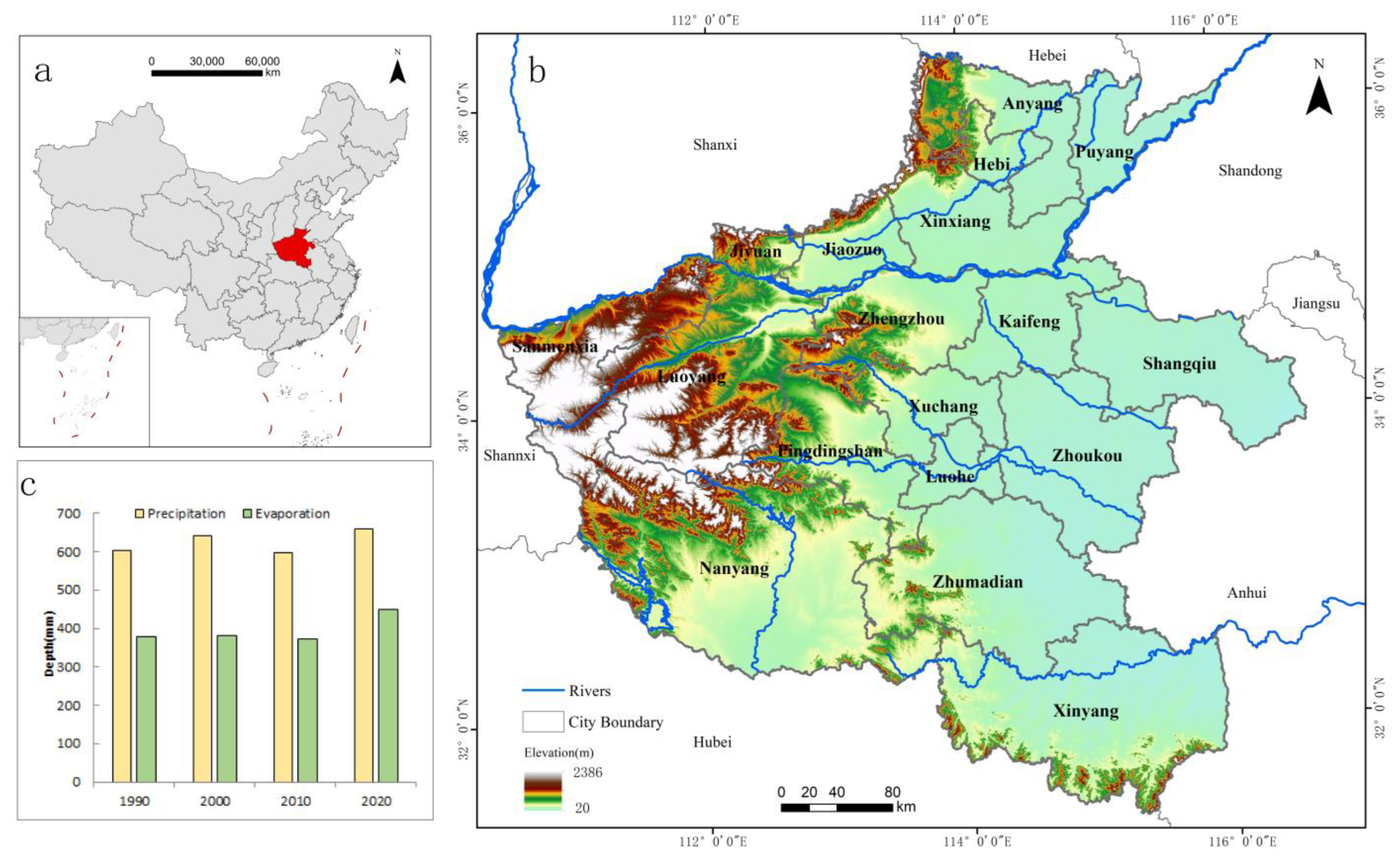
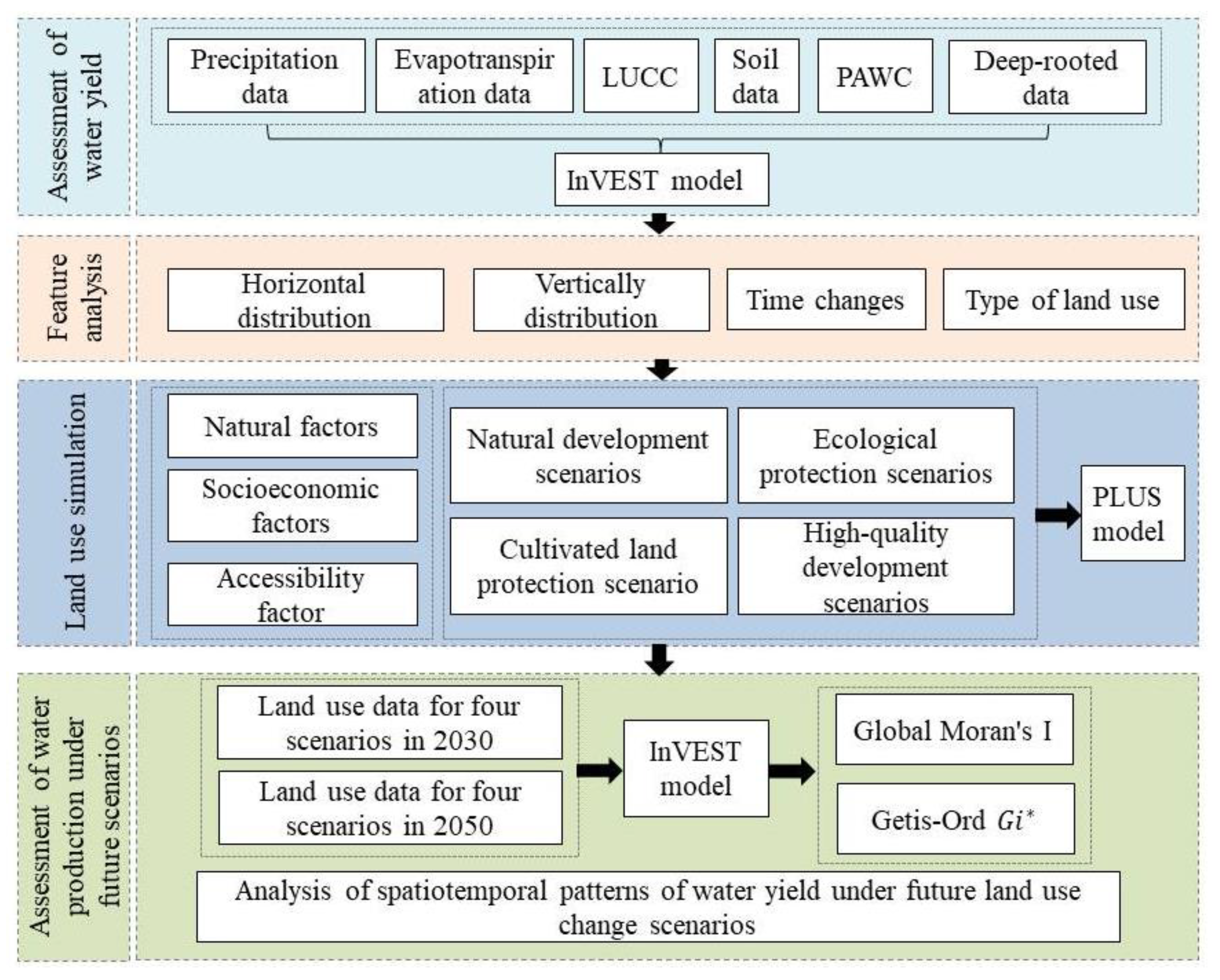
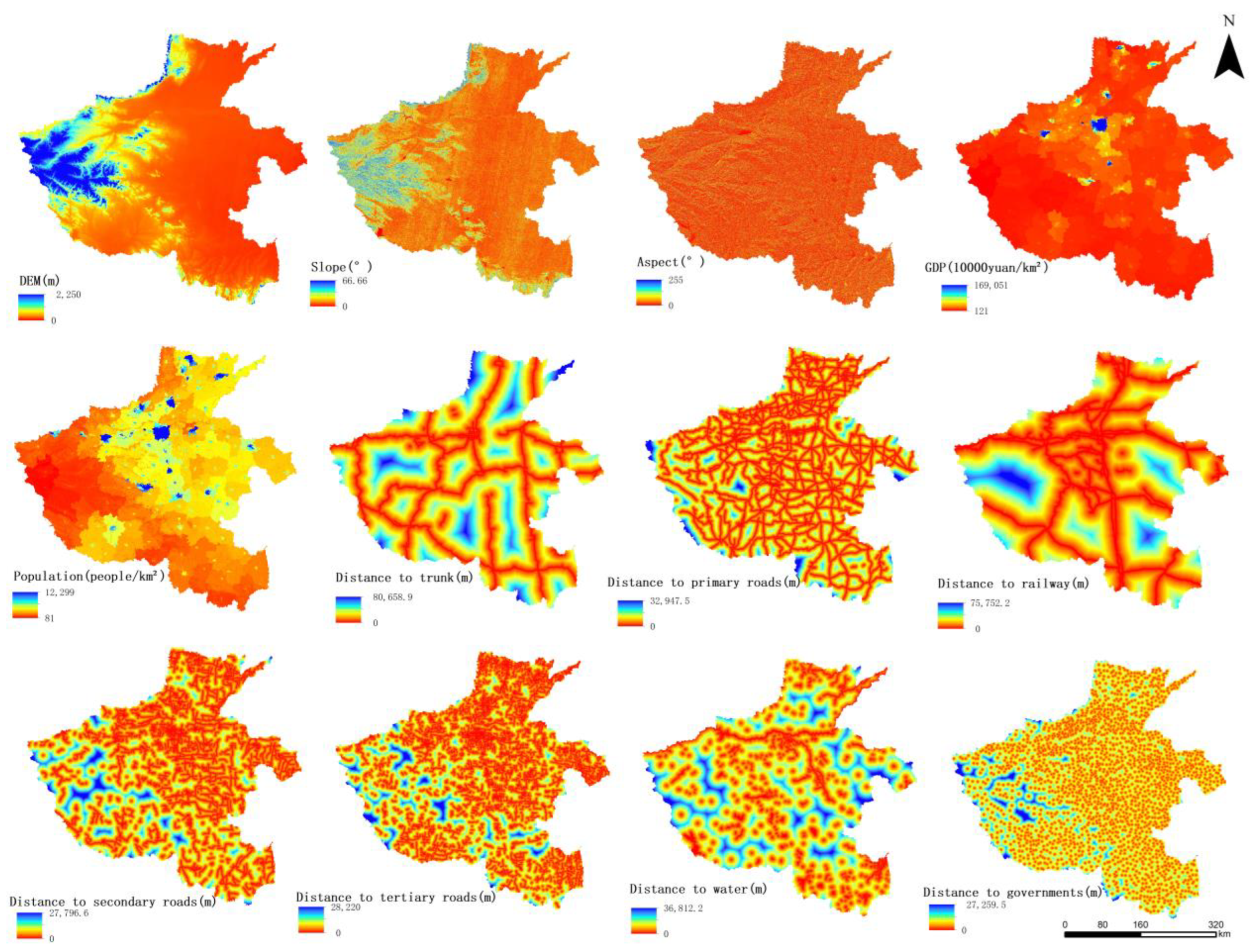
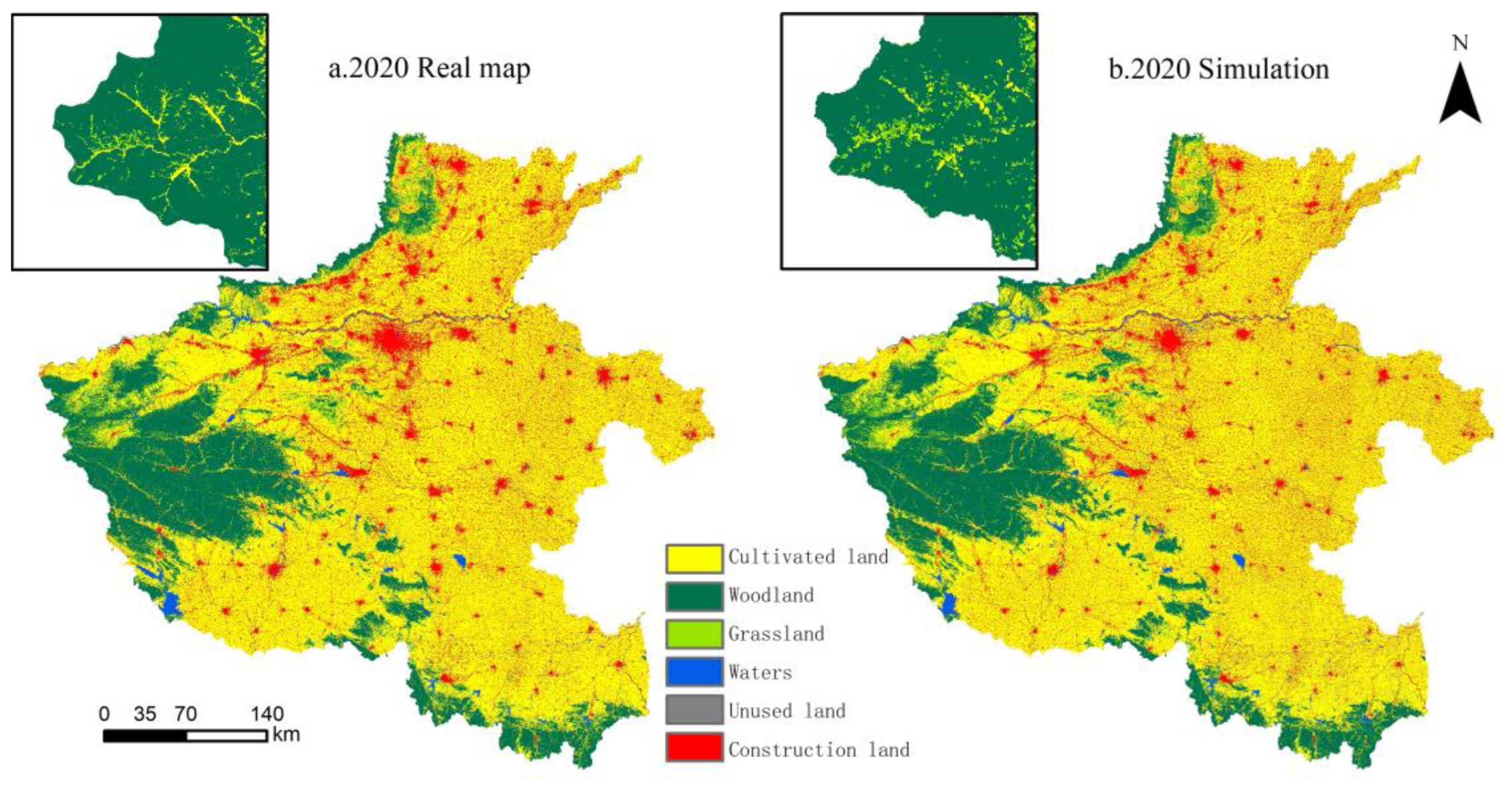

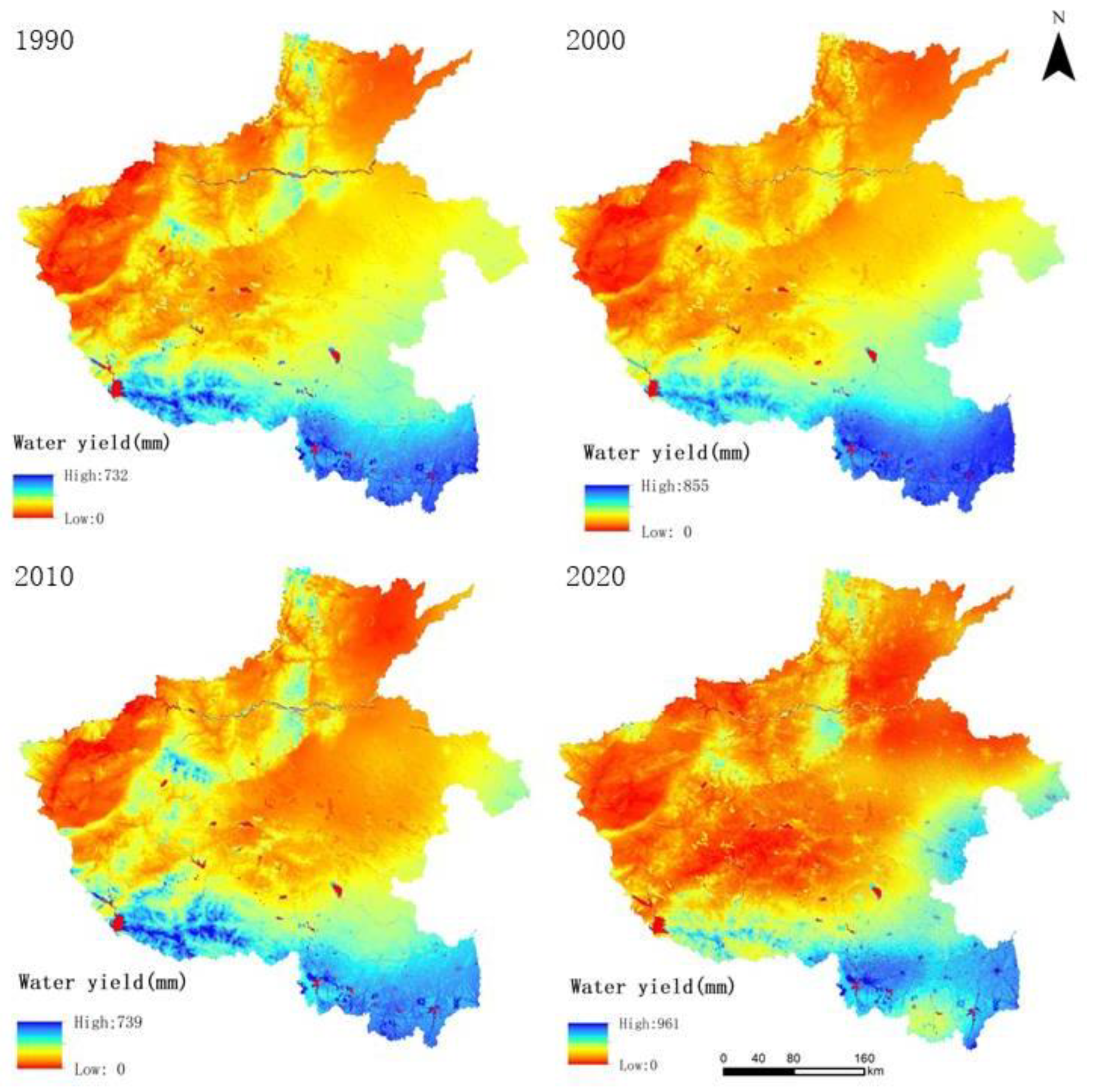


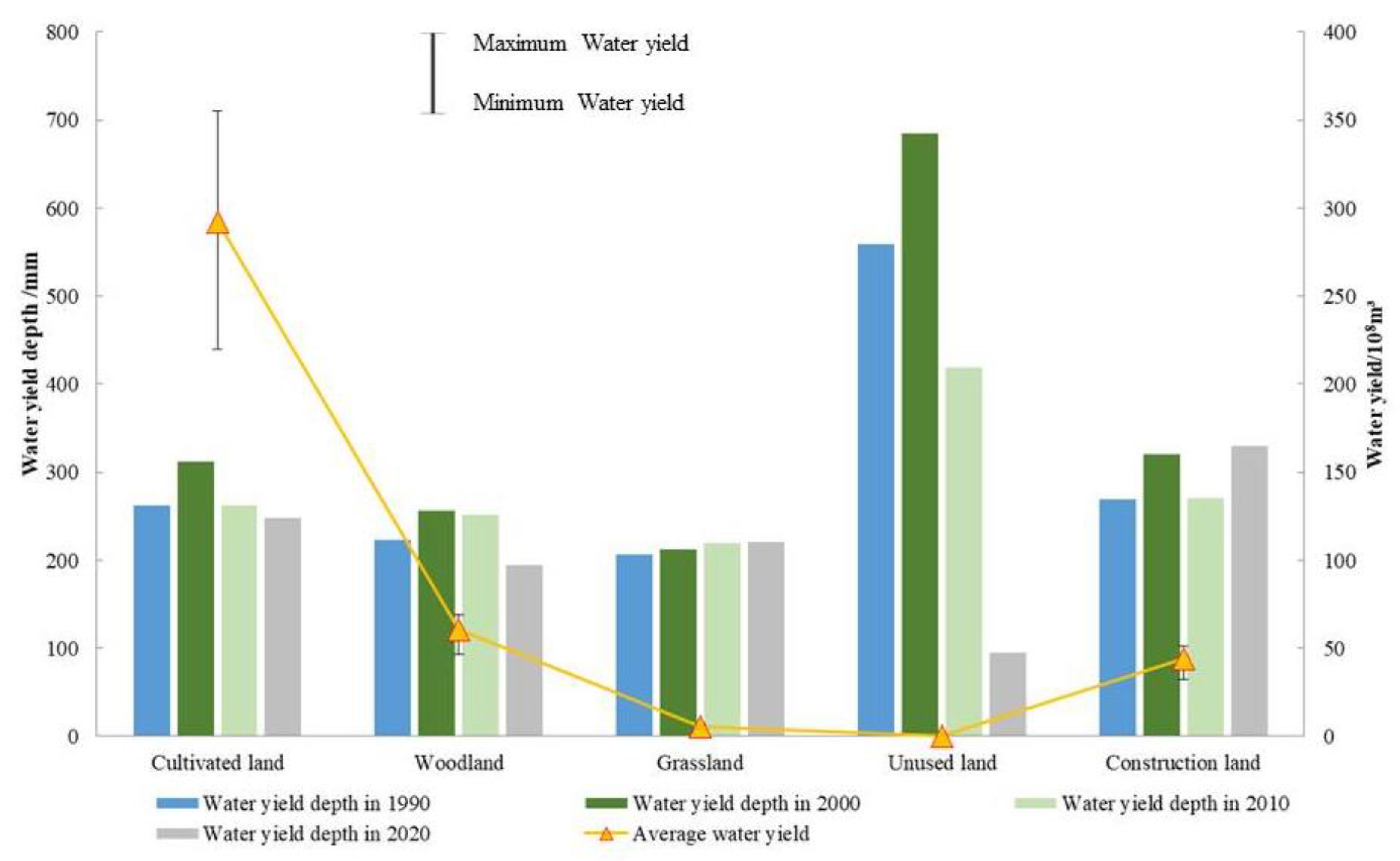

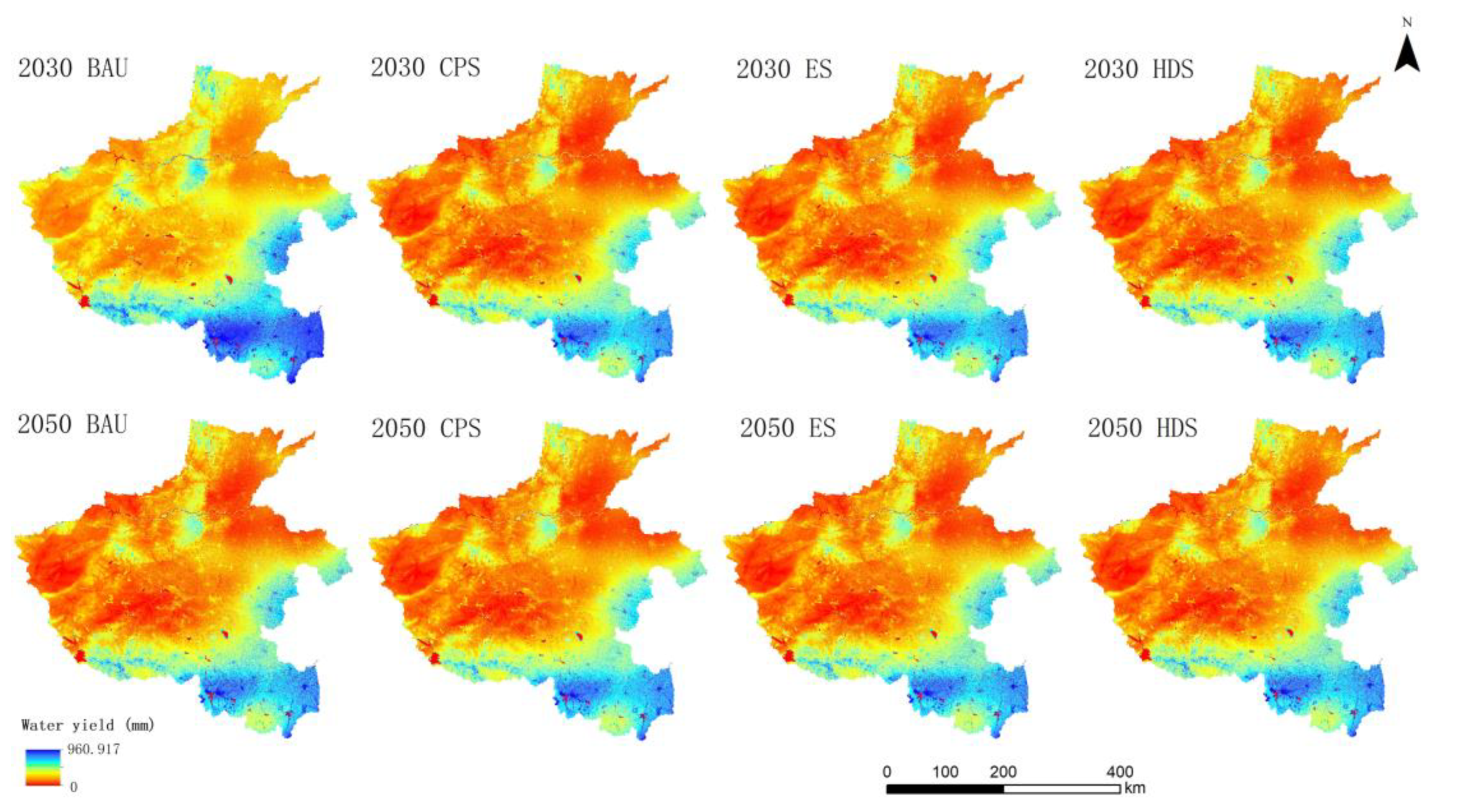
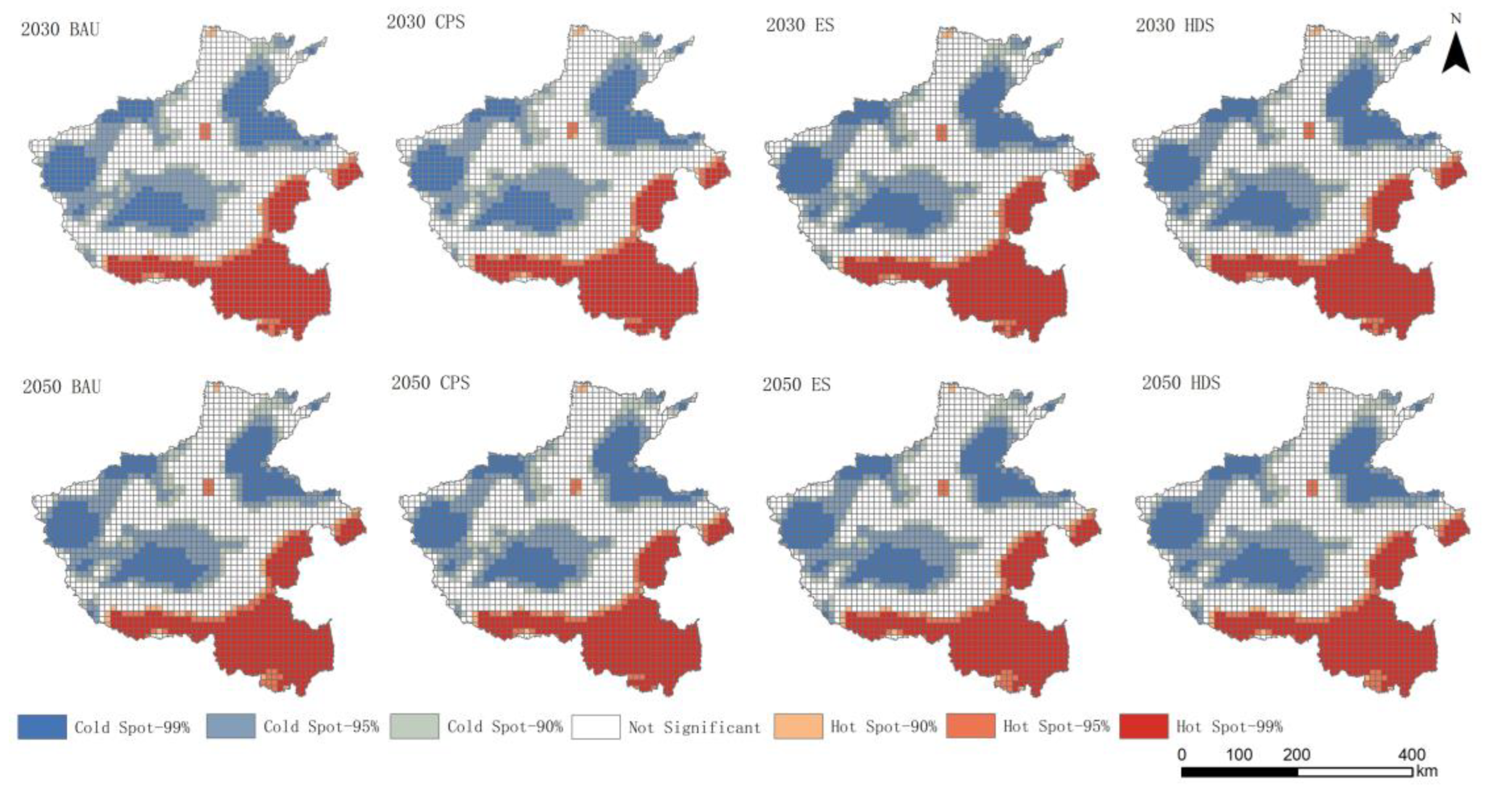

| Data | Original Resolution (m) | Data Resources |
|---|---|---|
| LULC | 30 | https://doi.org/10.5281/zenodo.5210928 |
| Soil | 1000 | http://www.ncdc.ac.cn/ (accessed on 2 November 2023) |
| Root restricting layer depth | 1000 | http://www.ncdc.ac.cn/ |
| PAWC (Plant Available Water Capacity) | 1000 | http://www.ncdc.ac.cn/ |
| Precipitation | 1000 | https://www.resdc.cn/ (accessed on 16 October 2023) |
| Evapotranspiration | 1000 | https://www.geodata.cn/ (accessed on 9 November 2023) |
| Watersheds and sub-watersheds | 30 | https://www.resdc.cn/ |
| DEM (Digital Elevation Model) | 30 | https://www.gscloud.cn/ (accessed on 18 November 2023) |
| Slope | 30 | https://www.gscloud.cn/ |
| Aspect | 30 | https://www.gscloud.cn/ |
| Population | 30 | https://www.resdc.cn/ |
| GDP | 30 | https://www.resdc.cn/ |
| Road network data | 30 | https://www.openstreetmap.org/ (accessed on 18 November 2023) |
| BAU | CPS | ES | HDS | |||||||||||||||||||||
|---|---|---|---|---|---|---|---|---|---|---|---|---|---|---|---|---|---|---|---|---|---|---|---|---|
| a | b | c | d | e | f | a | b | c | d | e | f | a | b | c | d | e | f | a | b | c | d | e | f | |
| a | 1 | 1 | 1 | 0 | 1 | 1 | 1 | 0 | 0 | 0 | 0 | 0 | 1 | 1 | 1 | 1 | 1 | 1 | 1 | 1 | 1 | 1 | 1 | 1 |
| b | 1 | 1 | 1 | 0 | 1 | 1 | 1 | 1 | 1 | 0 | 1 | 1 | 0 | 1 | 0 | 0 | 0 | 0 | 1 | 1 | 1 | 1 | 1 | 1 |
| c | 1 | 1 | 1 | 1 | 1 | 1 | 1 | 1 | 1 | 1 | 1 | 1 | 0 | 1 | 1 | 1 | 0 | 0 | 1 | 1 | 1 | 1 | 1 | 1 |
| d | 1 | 1 | 1 | 1 | 1 | 1 | 1 | 0 | 1 | 1 | 1 | 1 | 0 | 0 | 0 | 1 | 0 | 0 | 1 | 1 | 1 | 1 | 1 | 1 |
| e | 1 | 1 | 1 | 0 | 1 | 1 | 1 | 1 | 1 | 1 | 1 | 1 | 1 | 1 | 1 | 1 | 1 | 1 | 1 | 1 | 1 | 1 | 1 | 1 |
| f | 1 | 1 | 1 | 0 | 1 | 1 | 0 | 0 | 0 | 0 | 0 | 1 | 0 | 0 | 0 | 0 | 0 | 1 | 0 | 0 | 0 | 0 | 0 | 1 |
| Year | WY Depth (mm) | WY (108 m³) |
|---|---|---|
| 1990 | 224.98 | 407.04 |
| 2000 | 260.09 | 482.95 |
| 2010 | 226.71 | 415.81 |
| 2020 | 210.65 | 398.56 |
| Cultivated Land | Woodland | Grassland | Waters | Unused Land | Construction Land | ||
|---|---|---|---|---|---|---|---|
| 2030 | BAU | 104,433.41 | 30,382.16 | 1401.11 | 2099.13 | 2.39 | 27,264.98 |
| CPS | 106,712.51 | 30,422.58 | 1409.22 | 2106.33 | 2.41 | 24,930.12 | |
| ES | 106,633.05 | 30,992.6 | 1416.02 | 2124.53 | 2.42 | 24,414.55 | |
| HDS | 105,061.72 | 30,940.11 | 1410.41 | 2119.54 | 2.41 | 26,048.98 | |
| 2050 | BAU | 96,562.98 | 314,54.9 | 972.96 | 2281.66 | 2.29 | 34,308.37 |
| CPS | 98,669.23 | 31,492.26 | 980.46 | 2288.32 | 2.31 | 32,150.59 | |
| ES | 97,143.16 | 31,971.26 | 979.23 | 2303.64 | 2.3 | 33,183.58 | |
| HDS | 95,859.82 | 31,436.88 | 968.59 | 2202.1 | 2.1 | 35,113.68 |
| Cultivated Land | Woodland | Grassland | Waters | Unused Land | Construction Land | ||
|---|---|---|---|---|---|---|---|
| 2020 | 108,634.15 | 29,580.76 | 1896.87 | 2003.5 | 2.67 | 23,465.16 | |
| 2030 | BAU | –4200.74 | 801.4 | –495.76 | 95.57 | –0.28 | 3799.82 |
| CPS | –1921.64 | 841.82 | –487.65 | 102.77 | –0.26 | 1464.95 | |
| ES | –2001.1 | 1411.84 | –480.85 | 120.97 | –0.25 | 949.39 | |
| HDS | –3572.43 | 1359.35 | –486.46 | 115.98 | –0.26 | 2583.82 | |
| 2050 | BAU | –12071.17 | 1874.14 | –923.91 | 278.1 | –0.38 | 10,843.21 |
| CPS | –9964.92 | 1911.5 | –916.41 | 284.76 | –0.36 | 8685.43 | |
| ES | –11,490.99 | 2390.5 | –917.64 | 300.08 | –0.37 | 9718.42 | |
| HDS | –12,774.33 | 1856.12 | –928.28 | 198.54 | –0.57 | 11,648.52 |
| WY (108 m3) | Amount of Change (108 m3) | WY Depth (mm) | Amount of Change (mm) | ||
|---|---|---|---|---|---|
| 2030 | BAU | 401.42 | 2.85 | 212.54 | 1.89 |
| CPS | 399.85 | 1.28 | 211.23 | 0.58 | |
| ES | 398.1 | –0.47 | 210.5 | –0.15 | |
| HDS | 402.52 | 3.95 | 213.19 | 2.54 | |
| 2050 | BAU | 407.78 | 9.21 | 216.88 | 6.23 |
| CPS | 399.98 | 1.41 | 211.31 | 0.66 | |
| ES | 406.65 | 8.08 | 216.11 | 5.46 | |
| HDS | 408.89 | 10.32 | 217.51 | 6.86 |
| Cultivated Land | Woodland | Grassland | Unused Land | Construction Land | ||
|---|---|---|---|---|---|---|
| 2030 | BAU | 259.04 | 57.85 | 2.85 | 0.01 | 80.42 |
| CPS | 273.60 | 51.01 | 2.74 | 0.0 | 71.56 | |
| ES | 262.31 | 58.99 | 2.77 | 0.01 | 72.88 | |
| HDS | 256.74 | 57.72 | 2.85 | 0.01 | 84.11 | |
| 2050 | BAU | 242.43 | 59.59 | 2.09 | 0.01 | 102.25 |
| CPS | 275.27 | 50.88 | 2.00 | 0.01 | 70.75 | |
| ES | 243.55 | 60.83 | 2.21 | 0.01 | 98.68 | |
| HDS | 240.97 | 59.66 | 2.08 | 0.01 | 104.81 |
Disclaimer/Publisher’s Note: The statements, opinions and data contained in all publications are solely those of the individual author(s) and contributor(s) and not of MDPI and/or the editor(s). MDPI and/or the editor(s) disclaim responsibility for any injury to people or property resulting from any ideas, methods, instructions or products referred to in the content. |
© 2024 by the authors. Licensee MDPI, Basel, Switzerland. This article is an open access article distributed under the terms and conditions of the Creative Commons Attribution (CC BY) license (https://creativecommons.org/licenses/by/4.0/).
Share and Cite
Wang, S.; Cai, T.; Wen, Q.; Yin, C.; Han, J.; Zhang, Z. Spatiotemporal Dynamics of Ecosystem Water Yield Services and Responses to Future Land Use Scenarios in Henan Province, China. Water 2024, 16, 2544. https://doi.org/10.3390/w16172544
Wang S, Cai T, Wen Q, Yin C, Han J, Zhang Z. Spatiotemporal Dynamics of Ecosystem Water Yield Services and Responses to Future Land Use Scenarios in Henan Province, China. Water. 2024; 16(17):2544. https://doi.org/10.3390/w16172544
Chicago/Turabian StyleWang, Shuxue, Tianyi Cai, Qian Wen, Chaohui Yin, Jing Han, and Zhichao Zhang. 2024. "Spatiotemporal Dynamics of Ecosystem Water Yield Services and Responses to Future Land Use Scenarios in Henan Province, China" Water 16, no. 17: 2544. https://doi.org/10.3390/w16172544
APA StyleWang, S., Cai, T., Wen, Q., Yin, C., Han, J., & Zhang, Z. (2024). Spatiotemporal Dynamics of Ecosystem Water Yield Services and Responses to Future Land Use Scenarios in Henan Province, China. Water, 16(17), 2544. https://doi.org/10.3390/w16172544






